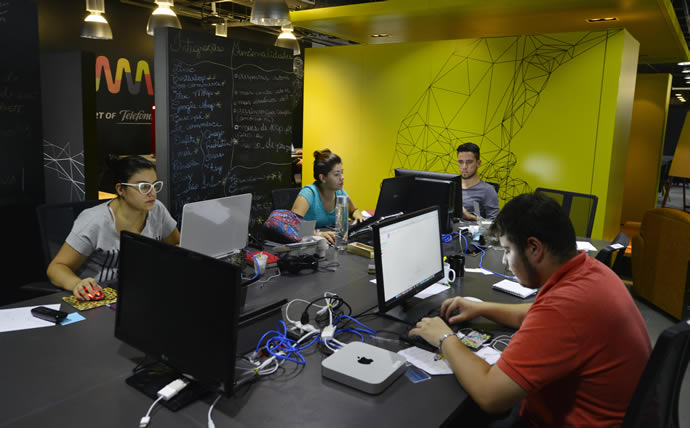Impeachment and rancor rake Brazil. A terrible earthquake strikes Ecuador.
Those events took place in a mere 24 hours this spring in South America, where the promise of growth is frequently stymied by tumult as hard to root out as a jungle vine.
The poster child for past troubles is Medellín, Colombia, a city name most can hardly hear without attaching the word “cartel,” and where decades-old paramilitary conflict still simmers even as it’s memorialized. But a generation or two have been ready to jump from that rut for some time. And it may be only natural that, in a land long known for its informal economy, a roving band of start-ups will lead the way forward.
Such clusters are rising across the continent, often under the banners of groups such as Endeavor Argentina, the Bolivian Entrepreneurship Network and others. This spring, Medellín welcomed thousands from those countries and more than 160 others for the Global Entrepreneurship Congress, where Maria Contreras-Sweet, head of the US Small Business Administration, led the Global Small & Medium Enterprises (SME) Ministerial.
“We all understand the important role of entrepreneurship in creating the dynamic social fabric of our societies,” said Contreras-Sweet, who appeared in Bogotá ahead of the event to announce that Colombia will be adding its 117 National Service for Apprenticeship and Learning (SENA) centers to the Small Business Network of the Americas, a 20-nation program modeled after the SBA’s Small Business Development Center concept, and which has already spawned hundreds of centers across the region. “Entrepreneurship is a fundamental economic strategy. But it’s also a core security strategy, giving people alternatives to crime and extremism so they can imagine a better future. If you can’t get a job, entrepreneurship allows you to create your own. And small businesses not only create most of the jobs in our global economy, they also create a sense of pride in local neighborhoods and contribute tax revenues that can help fund better services and better schools.”
Hundreds of business education centers have opened across Latin America since 2013. “Last year alone, these centers served nearly 20,000 businesses,” said Contreras-Sweet. “By partnering to expand entrepreneurship across Colombia, our governments will provide opportunities for women, young people, and rural Colombians to create jobs and forge a lasting peace.”
Wanted: Ecosystems and Cooperation
Another leader in attendance in Medellín was Mariano Amartino, a native Argentinian who is global director of Wayra, Spanish telecom giant Telefónica´s OpenFuture start-up accelerator network. Wayra’s operations encompass 12 countries — Germany, Argentina, Brazil, Chile, Colombia, Spain, Ireland, Mexico, Peru, United Kingdom, Czech Republic and Venezuela and a partnership in China with VIV accelerator and China Unicom — where Wayra has a portfolio of 528 companies in 20 different digital industries.
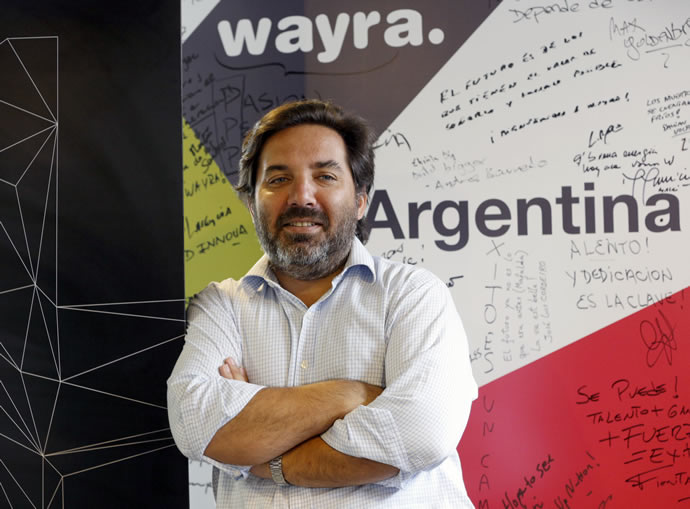
Wayra’s operations in Latin America include spaces in Argentina, Chile, Peru, Brazil, Colombia, Venezuela and Mexico, as well as pre-accelerator spaces in Costa Rica and Ecuador. “We are opening in Panama, and are now in talks with Jamaica and Paraguay,” he says in an interview on the sidelines of the Medellín event. “In Brazil, we are opening seven this year.”
Altogether, Wayra’s global network has seen 7,000 direct jobs created by investments by Wayra or its companies. Amartino says the unit’s first foray into Latin America was based on finding places with a strong Telefónica presence, and significant populations with pools of talent. Bogotá came first, then Sao Paulo, Buenos Aires, and cities in Chile and Mexico. “You have some other countries where there are no ecosystems, but we truly believe there is a lot of talent,” he says. “That’s why we went into Caracas, or Lima.”
Indeed, Lima is investing heavily in improving its education system. “Usually corporations don’t see it as a major destination, but it’s a stable market, and now part of the Pacific Alliance,” Amartino says, noting the market alliance of Peru, Chile, Colombia and Mexico. “There are a lot of laws that help you export services and open companies really fast. You are seeing there a nice ecosystem to create innovation.”
Wayra doesn’t invest in the start-ups, but connects them with its global mentor and content network in ICT and Internet arenas, and keeps a close eye on the entrepreneurs. “Sometimes those entrepreneurs can become companies,” he says. “For instance, in Costa Rica, I was with the president and first lady in November, and they were amazed. We have 10 entrepreneurs in the Costa Rica co-working space, and eight became projects. It seems to me at least six of them will become companies.”
Keeping Score
Asked to assess the entrepreneurial reality and potential of cities across the region, he says some cities are entrepreneur-friendly, and some have entrepreneurial spirit, if not infrastructure. He sees a lack of cooperation between ecosystems, and in some cases no ecosystem at all: “In Venezuela, for instance, it’s really hard to build something on a global scale. Go to Peru, and there is a smaller ecosystem in Lima, but they are trying to build a huge impact with the Pacific Alliance. Go to Chile, and you have one of the most law-abiding countries, and security for companies. You have a good framework of free market laws there. But you don’t have a lot of entrepreneurial history.”

An April 2016 report from the Global Cities Initiative (a joint project of the Brookings Institution and JPMorgan Chase) and the Centro de Estudios Públicos (CEP) benchmarks the Santiago Metropolitan Region’s competitiveness against eight other regions globally that resemble its size, wealth, productivity, and industrial structure (Hangzhou, Nanjing, Johannesburg, Warsaw, Istanbul, Mexico City, Rio de Janeiro, and Ankara). The metro area accounts for nearly half of Chile’s GDP, and in a composite economic performance index, Santiago placed third among the nine regions.
“Santiago boasts an increasingly well-educated workforce, major universities, and a stable of large global companies and budding start-ups,” said Joseph Parilla, senior research associate, Brookings Institution Metropolitan Policy Program, and co-author of the report. “These strengths position it to lead Chile toward a more productive, technology-intensive economy that competes in global markets based on knowledge rather than raw materials.”
Like Amartino, however, the Brookings authors see challenges, including an upgraded and more accessible education system, better regional infrastructure planning, and the need for more collaboration between universities and companies.
Asked to rate the South American countries on how well startups link to corporations, Amartino says, “Argentina, Brazil and Colombia, and in fourth place I would put Chile.” That’s based on real practice, as one of his key performance indicators for Wayra outposts is how well the startups are linking to Telefónica and its other customers. In Argentina, such linkages have produced launches of firms such as Negocios and Movistar Agro. But Amartino says corporations need to put forth some effort too.
“The main problem for corporations is they think of Latin America as one market,” he says of a region that encompasses 20 nations. “If there’s one thing Latin America is not, it’s one single market.”
Still Buying
Amartino lives in Madrid now, but is an Argentinian by birth, and reserves his most caustic criticism for his native country.
“In Argentina, there is a socioeconomic crisis once every 10 to 15 years,” he says. “The world is amazed every time at how we [mess] things up in a really nice country. You have to be an entrepreneur to thrive under those circumstances.”
That said, Argentina traditionally boasts the best education system and some of the top universities in South America, in terms of technical engineers and STEM-skills graduates. Amartino also lauds the increased education investment he’s seeing in Peru and Colombia, and points out strong universities and graduate talent pools in Santiago, Chile, and in Sao Paulo, Brazil.

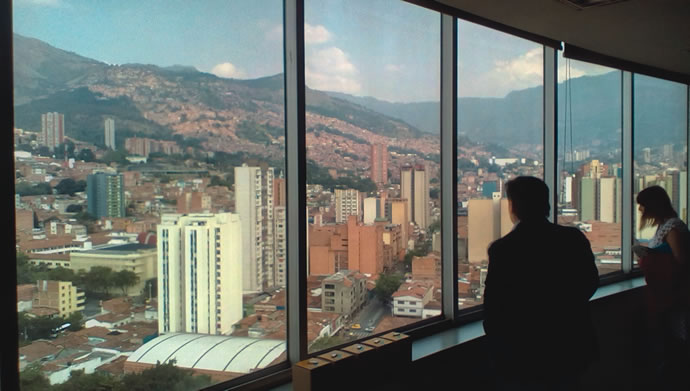

As for often overlooked territories, Amartino says Wayra is hoping to launch co-working spaces in Montevideo, Uruguay, and in Asuncion, Paraguay, later this year. In Montevideo, he says, a growing technological district is taking shape, and Uruguay as a whole, though small, is a good launching point for services to other countries.
“There is still a huge competition among cities to become the hub of innovation and startups,” Amartino says. “You have Medellín, Bogotá, Miami, Buenos Aires. When you look at Brazil, it’s its own universe — speak with entrepreneurs there, and they are looking at first rounds of investment, and to grow and conquer new markets in the north or south of Brazil.”
Even so, having a partner there is a must.
“In Brazil, if you don’t have a strong local presence and partner, you can’t do business,” he says. “But once you get into that market, the size of the market is huge — really, really huge.”
Even as currencies in multiple South American nations crash against the US dollar, he says, the fundamentals show promise.
“The people are buying new products and new online products. Even when their incomes are going down, usage is going up. It’s a good moment to bulid a loyal customer base.”
He singles out Colombia as among the most impressive and “amazing, if not a miracle” in its growth.
“Fifteen years ago, I remember having to be in an armored car, and being searched going into a restaurant by a bomb-sniffing dog,” he says. “Compare that with this Colombia, and you realize society is growing. The people are trying to solve issues, but have a really well prepared managerial class. You find executives in Colombia who are world-class, educated around the world, and trying to improve education here. And at the same time, they are trying to innovate in a lot of fields,” including movement toward a less cash-intensive, more digital consumer payment economy. Moreover, he says, “In Colombia you can see that this is a state policy, not an administration policy, and this is really, really good.”
Watch for more coverage of South America in the July print issue of Site Selection magazine.
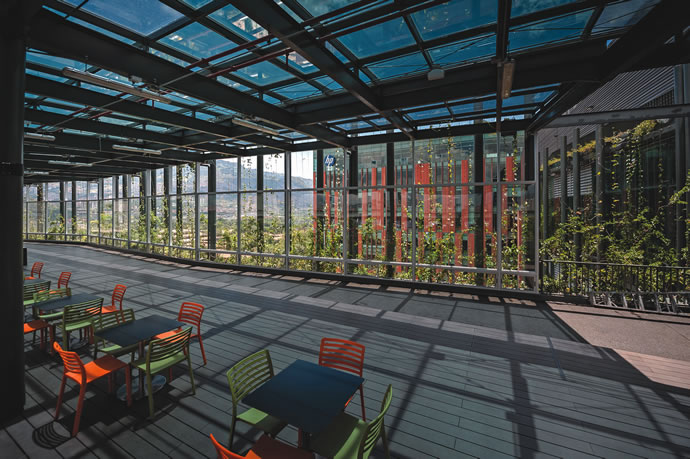
Pick Myself Up, Dust Myself Off
| Country | Rank 2013 | Rank 2016 | Predicted Rank 2020 |
|---|---|---|---|
| Argentina | 26 | 39 | 39 |
| Brazil | 8 | 29 | 23 |
| Colombia | 31 | 36 | 34 |
The 2016 Global manufacturing competitiveness index from Deloitte Touche Tohmatsu Limited (DTTL) Global Manufacturing Industry Group and the Council on Competitiveness reveals country rankings and competitiveness drivers across 40 nations through a survey of some 550 of the world’s leading manufacturing CEOs and senior executives. The index features only three South American countries, all of which have fallen, but are expected to rise again. The table has the rankings in the previous (2013) and current indices, and their predicted rank in 2020:
More Data Please
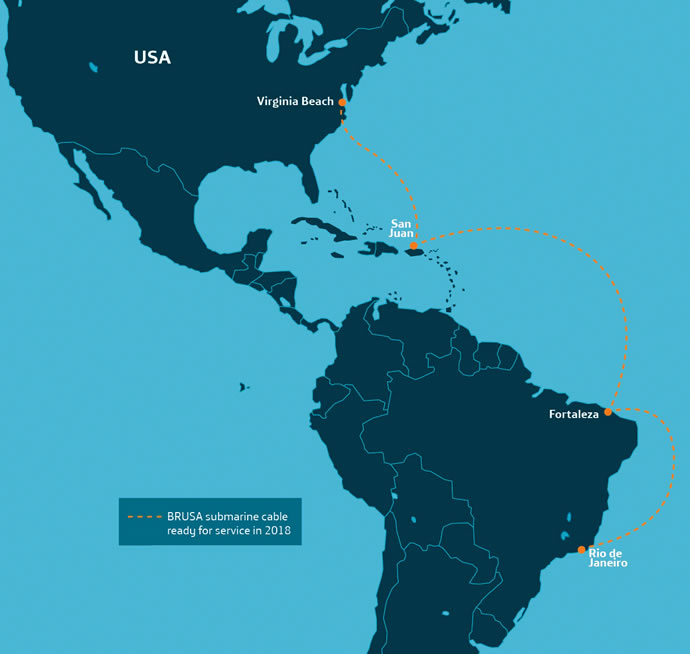
Spain telecommunications giant Telefónica announced in March the deployment of BRUSA, a new submarine cable nearly 11,000 km. (6,837 miles) in length linking Rio de Janeiro and Fortaleza (Brazil) with San Juan (Puerto Rico) and Virginia Beach (USA). The cable is expected to begin operations in early 2018. The company said the new cable would “provide one of the lowest latency communication links between the two largest economies in the region, Brazil and USA, and will offer a greater flexibility and scalability than previously deployed systems.”
Telefónica has recently strengthened its infrastructure in the Americas with the deployment of the Pacific Caribbean Cable System (PCCS), a consortium submarine cable with a transmission capacity of up to 80 Tbps, which links Jacksonville, Florida with the British Virgin Islands, Puerto Rico, Aruba, Curacao, Colombia, Panama and Ecuador. In addition, Telefónica also manages the Unisur cable connecting Uruguay and Argentina and the SAM-1, a submarine cable system forming a 25,000-km. (15,538-mile) ring linking the US, the Caribbean and Central and South America.
Illustrating the reasons behind such infrastructure development, Equinix in March announced its new SP3 data center in São Paulo in order to address increasing demand for colocation in the State of São Paulo, as Equinix’s SP2 facility in Tamboré is nearing capacity. SP3 — one of four facilities the company announced in March, including locations in Sydney, Tokyo and Dallas — will double the company’s capacity in Brazil, as more businesses outsource IT and leverage the cloud.
